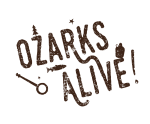History can now sing in living rooms across the country: The Ozark Jubilee Digitization Project, a years-long effort to share more than 70 episodes of the 1950s TV show with new generations of viewers, is officially complete. In contrast to when episodes were initially aired, however, you don’t need a TV in your living room to watch them. YouTube is now the channel of choice.
“The Ozarks has a very rich and varied musical and entertainment tradition … but the Ozark Jubilee was the most important and foundational,” says Tom Peters, dean of Missouri State University Libraries, which led the project. “Lots of local Ozarks musical, comedic, and dance talent appeared on the Jubilee, as well as nearly every major country and western music star from that era.”
More than 50 years since its end, eyes that saw the Ozark Jubilee in its initial run are dwindling. The weekly musical variety show originated from Springfield and helped boost the careers of both local and nationally known musical artists, featuring names such as Brenda Lee and Porter Waggoner. It also made Springfield the country’s third leading producer of network television, coming in just after New York and Los Angeles. (Note: For more info about the Jubilee, click here to read an Ozarks Alive article on the show from 2016.)
Its significance led Peters to undertake the effort to digitize episodes and make them available to the public online. That likely wouldn’t have happened, however, without Wayne Glenn, a longtime local radio host and fan of the Ozark Jubilee. Several years ago, he discovered a collection of episodes — preserved on kinescope, an early form of recording that predates videotape — that were housed at the University of California - Los Angeles (UCLA).
“I have been saying for many years that when it comes to the ‘entertainment scene’ in the Ozarks there has never been anything to compare with the impact that the Jubilee had on the area,” says Glenn. “Basically from January 1955 into 1961 the show — with slightly different names — reached millions of people through TV weekly. No other regular event of the Ozarks has done that for so long.
“When I learned that a good number of those shows were sitting on the West Coast I felt that somehow they should be ‘copied’ and made available to a broad public. Frankly, I was very surprised that I was the first one — in my little network of friends — to notice it.”
Glenn says he knew he could not execute a digitization project himself, so he began making calls. After speaking with individuals at Ozarks Public Television, he was directed to Peters, who had recently joined MSU and says he was “vaguely aware” of the Jubilee. That reality would soon change: Since that conversation around a decade ago, Peters has become one of the region’s leading authorities on the Jubilee, and will soon publish a two-volume book set chronicling its history.
Want to learn more?
Click here to watch episodes now available through the Ozark Jubilee Digitization Project.
But even back then, Peters realized that this project could be important.
“After some negotiations, the UCLA archive agreed to digitize their kinescopes, send copies of the digitized files to the MSU Libraries, and allow the MSU Libraries to make them freely available online to the general public,” says Peters.
That effort is important to people like Jaynie Chowning, whose father was Si Siman, one of the primary proponents behind the Jubilee’s success.
“This show was an historical piece of early television and launched many early ‘stars’ into their own exciting careers,” she says. “Having MSU digitize these episodes and put them up for public viewing was a large task, and I'm thankful that they had the foresight and ambition to do this for all of us.”
The project was a gradual one. Part of that was tied to the amount of work involved, which continued in Missouri after each file was received from UCLA.
“Once the massive files were received from the UCLA Film and Television Archive, employees of the MSU Libraries, primarily Nathan Neuschwander and Craig Amason, worked to clean up the files,” says Peters, who notes that most of the digitized episodes are from 1955 and 1956, the first two years that the Ozark Jubilee was broadcast nationally over the ABC-TV network. “Sometimes enhancing the sound and video quality, adding closed captioning and other types of metadata, including the extremely useful navigable lists of the various performances — music, dance, comedy, and commercials — from each 30-minute segment. It was painstaking, detail work.”
Another element of the project’s progression was the financial resources required to make it happen, given that each episode cost $2,500 to digitize. Some came from private donations and carryover library funds — money that is unused from an annual budget and allowed to “carry over” to the next — while others came from grants.
Examples of the latter, Peters notes, include a “major gift” from the Martin Family Foundation, which he says provided sufficient funding to finally complete this project, as well as a grant from the Grammy Museum Foundation.
Those episodes are now available on YouTube for the world to see, perhaps providing a new way to learn about the region and its history.
“The Ozark Jubilee had a tremendous impact on the growth and development of the entertainment and tourism industry in the Missouri Ozarks,” says Peters. “A good argument could be made that, without the Ozark Jubilee, the Branson entertainment phenomenon would not have developed when, where, and how it did.”



